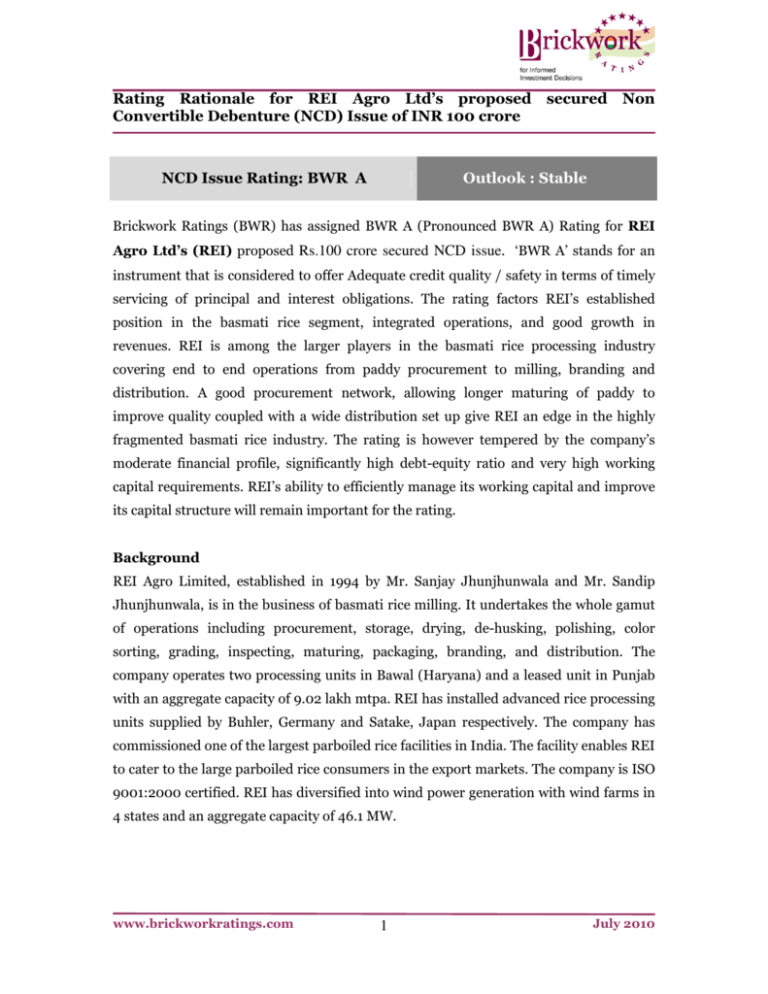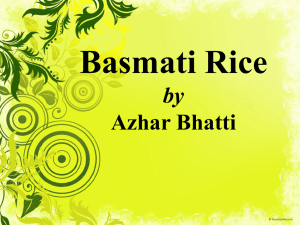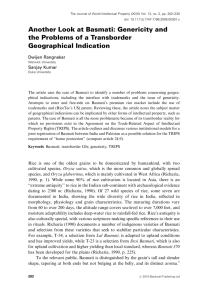1 Rating Rationale for REI Agro Ltd's proposed secured Non
advertisement

Rating Rationale for REI Agro Ltd’s proposed secured Non Convertible Debenture (NCD) Issue of INR 100 crore NCD Issue Rating: BWR A Outlook : Stable Brickwork Ratings (BWR) has assigned BWR A (Pronounced BWR A) Rating for REI Agro Ltd’s (REI) proposed Rs.100 crore secured NCD issue. ‘BWR A’ stands for an instrument that is considered to offer Adequate credit quality / safety in terms of timely servicing of principal and interest obligations. The rating factors REI’s established position in the basmati rice segment, integrated operations, and good growth in revenues. REI is among the larger players in the basmati rice processing industry covering end to end operations from paddy procurement to milling, branding and distribution. A good procurement network, allowing longer maturing of paddy to improve quality coupled with a wide distribution set up give REI an edge in the highly fragmented basmati rice industry. The rating is however tempered by the company’s moderate financial profile, significantly high debt-equity ratio and very high working capital requirements. REI’s ability to efficiently manage its working capital and improve its capital structure will remain important for the rating. Background REI Agro Limited, established in 1994 by Mr. Sanjay Jhunjhunwala and Mr. Sandip Jhunjhunwala, is in the business of basmati rice milling. It undertakes the whole gamut of operations including procurement, storage, drying, de-husking, polishing, color sorting, grading, inspecting, maturing, packaging, branding, and distribution. The company operates two processing units in Bawal (Haryana) and a leased unit in Punjab with an aggregate capacity of 9.02 lakh mtpa. REI has installed advanced rice processing units supplied by Buhler, Germany and Satake, Japan respectively. The company has commissioned one of the largest parboiled rice facilities in India. The facility enables REI to cater to the large parboiled rice consumers in the export markets. The company is ISO 9001:2000 certified. REI has diversified into wind power generation with wind farms in 4 states and an aggregate capacity of 46.1 MW. www.brickworkratings.com 1 July 2010 REI Six Ten Ltd. REI Agro started its retail division in 2006-07 to enable the company to tap its existing wide network with farmers and state mandis. Subsequently, in October 2008, the company demerged its retail business into a separate entity i.e. ‘REI Six Ten Retail Ltd.’ to focus on its core business. The demerger was completed in October 2008 w.e.f August 2007. REI Six Ten Retail Ltd. focuses mainly on food and grocery retail. REI sells its rice brands through its Six Ten retail outlets aggregating to about 10-12% of REI’s total sales. Security for the NCD issue and use of funds The issuers will provide security by way of first pari-passu charge on fixed assets of the Rice Division valued at about Rs. 260 crores with the replacement value equivalent to about one time cover for the proposed NCD issue. BWR has relied upon the company’s declaration as regards the description, titles, value of assets and nature of charges to secure the proposed NCD issue and no independent verification or assessments thereof have been made by BWR. The company will be appointing a SEBI registered Debenture Trustee who will be vested with appropriate powers and authority to create necessary charge over the assets to secure the NCDs and to take all such steps to protect the interests of the debenture holders. Funds raised through the NCD issue will be used towards meeting the Company‘s working capital requirements and for other general corporate purposes. Business Segments Basmati Rice REI has an established position in the fragmented basmati rice industry and is a leading processor of basmati rice. The company controls about 22% share of the basmati rice industry in India making it among the larger basmati rice companies in the world. The company’s product basket includes full head, broken and par boiled basmati rice and sells a range of branded and unbranded basmati rice. Whole grain basmati www.brickworkratings.com 2 July 2010 rice is sold both in branded and unbranded form whereas the broken basmati rice is sold only in branded form. The company has a presence across multiple price segments in branded basmati rice to have a wider market spread. Premium – Products in the name of Kasauti, Real Magic Midrange - Products in the name of Mr. Miller, Iron Economy - Products in the name of Hansraj, Raindrop REI has a state of the art processing facility for par boiled basmati rice which is largely for the export markets of Saudi Arabia, the United Arab Emirates and Kuwait. REI sells unbranded par boiled rice to third parties which are packaged and sold by them under their respective brands. REI exports the entire production of its par boiled rice. The company has tie ups with retail chains like Big Bazaar, Shoprite, 6ten etc., and a large network of wholesalers and institutional clients in hotel, aviation industry etc. for sale of its products. The company has widened its pan-India presence through about 490 dealers & 100,000 retail outlets for its branded products. Its has focused its parboiled rice specifically on the export markets of Middle East while its branded products are targeted across all its export markets. In the domestic market, it has a strong presence in Northern and Western India. Integrated Operations: The company has a very good procurement network with presence in about 65% of all the basmati ‘mandis’ in India and enjoys ‘preferred buyer’ status which results in cost effective sourcing of quality paddy. REI follows an integrated business model and undertakes all activities right from paddy purchase, maturing, processing, packaging and marketing. Maturing of basmati rice (ageing) for 12- 18 months is necessary for good quality rice output. This results in improved yield (lower breakage) and higher average realizations. The company has over the years increased its maturing period from 8-9 mths in 2005-06 to 12-14 months in 2009-10, which has resulted in higher realizations for REI contributing to growth in top line. The company operates processing units in Bawal (Haryana) with an aggregate capacity of 61 TPH and leased units in Punjab with capacity of 42 TPH which are located in the heart of the basmati belt. The company has installed advanced rice processing units, supplied by www.brickworkratings.com 3 July 2010 Buhler, Germany. It has a pan-India presence through about 490 dealers and 100,000 retail outlets in the domestic market and a strong presence in the global markets particularly UAE and Saudi Arabia through dealers in destination countries. REI’s focus on basmati rice, raw and par boiled, strong procurement and processing set up together with its wide distribution network has enabled it to steer ahead of competition with net sales (FY09) almost twice the revenues of its closest competitor. Cost effective paddy procurement has helped REI’s operating margins at higher levels than its peers. REI’s PAT margins, however, remain suppressed by higher interest and working capital costs. Wind Power The company has also diversified into the business of wind energy generation to reinforce it revenues and profits, by setting up wind farm facilities in Maharashtra (7.5 MW), Rajasthan (22.4 MW), Tamil Nadu (6 MW) & Gujarat (10.2 MW) with an aggregate capacity of 46.1 MW. The wind farm at Rajasthan is registered with the United Nations Framework Convention on Climate Change and has already received 25,094 CERs (Certified Emission Reduction) under the Kyoto Protocol. Revenues from the wind power segment constituted about 1% of REI’s estimated total revenues in FY10. Financial Performance: Strong Revenue Growth: REI Revenue break up has registered a strong growth in revenues with a CAGR of ~40% mn in FY07 to 500 Rs.9988 mn in FY09. REI’s cost 999 316 148 1,000 1,449 Rs.1481 1,500 1,419 from 2,000 937 has steadily grown its exports as well Rs. Crs during FY2006-FY10. The company 2,500 - effective procurement enables it to 2007 2008 2009 Domestic sales Exports maintain its EBIDTA margins at healthy levels in the range of 18 – 18.3%. In FY10, due to the crisis in the Middle East, the company on a prudent basis, undertook only cash sales in the region to ensure sales www.brickworkratings.com 4 July 2010 realizations. This lowered its exports to the region. Going forward, expanding its reach in the domestic market while gradually increasing its exports will remain REI’s key focus. High Working Capital Requirements: REI has very high working capital requirement. REI production has increased steadily over the years from 194 MT in FY03 to 430MT in FY09. With the increase in scale of operations, the working capital requirement has also increased. The company matures rice up to 14 months to get better quality rice and higher realizations due to lower breakage. Inventory days have increased from 382 days in FY07 to 421 days in FY09. This increases the inventory carrying cost. Correspondingly working capital requirements and interest costs are also significantly higher. Interest cover declined to 1.34x in FY2009 from 1.79x in FY08, however has improved to an estimated 1.69x in FY2010. Working capital loans comprise over 85% of its total debt as on March 31, 2009. Moderate Financial Profile: REI has a moderate capital structure with significantly high gearing at 5.3 times as on March 31, 2009. EBITDA margins are healthy at about 18.2%, however, high interest costs coupled with export duty imposed by the Government of India have affected net profit margins in 2009. REI’s profitability margins are also average at 5.94% and 2.49% in FY08 and FY09 respectively. In November 2009, REI raised USD 105 mn by way of issue 105000 FCCB’s. Further, the company is also proposing a rights issue (shareholder approval pending). Improvement in gearing levels and interest cover will be key for the company. The possible equity infusion through the proposed rights issue and conversion of FCCB’s (previous FCCB issued in 2005 was fully converted before maturity) could ease gearing levels going forward. www.brickworkratings.com 5 July 2010 Key Financials: Net Sales (INR mn) EBITDA (INR mn) PAT (prior to deferred tax charge) (INR mn) PAT (post deferred tax charge) (INR mn) Networth (INR mn) Total Debt (INR mn) Equity Capital (INR mn) Total Debt/Tangible Networth (x) Interest Coverage (x) Debt-Service coverage ratio (x) Operating Margins (EBITDA/ Op Income) (%) Profitability margins (PAT/Op Income) (%) (including deferred tax) Return on capital employed (%) Net cash accruals to total debt (x) Current ratio (x) 2009 24482 4456 609 622 5622 30148 29 5.36 1.34 0.61 18.20 2008 17350 3170 1031 814 5053 23560 29 4.66 1.79 0.24 18.27 2007 10852 1986 911 719 4221 13313 45 3.15 2.57 0.27 18.30 2.49 11.67 0.03 12.23 5.94 10.18 0.05 25.02 8.39 10.05 0.07 19.23 Notes: − Reduction in capital in FY08 due to demerger of retail division and subdivision of capital from face value Rs.10 to face value Rs.1. − Total debt includes preference share capital of Rs.40 crore − The company, as per the order of the High Court of Kolkata has routed deferred tax liability through securities premium a/c. The same has been charged to P/L by BWR. Impact on PAT is reflected above. Nine Months Results Net Sales OPBDIT PAT Interest Cover 9M FY2010 9M FY2009 Rs. Mn % Rs. Mn % 24788 100 17072 100 4561 18.4 3389 19.9 1249 5.0 545 3.2 1.81 1.42 For the nine months ending 31st December 2009, revenues were Rs.24788 mn up 45% from Rs. 17072 mn in the corresponding previous period while net profits grew to Rs. 1249 mn from Rs. 545 mn for the same period. During the period, increase in paddy prices in the initial months reflected in slight fall in EBITDA margins from 19.9% to 18.4%. www.brickworkratings.com 6 July 2010 Industry Background India is the largest producer and exporter of basmati rice. Of the total global production of basmati rice approximately 75% comes from India and the balance from Pakistan. In India basmati rice is grown on the foothills of Himalayas, the northern part of western Punjab, Haryana, Western Uttar Pradesh and Uttarkhand. The annual production of basmati rice in India is around 10-15 lakh tonnes p.a. and the industry growth rate is 6% p.a. About 65% of the basmati market is controlled by unorganized players. Larger corporate players who can afford advanced milling technologies and backed by economies of scale play a prominent role in the organized segment. Approximately Rs. 3500 crore worth of basmati rice is produced in India of which only rice worth Rs. 500 cr is sold in branded form. The domestic consumption of basmati is less due to the fact that basmati remains a premium product in terms of pricing. With growing per capita income and preference for better quality, the domestic demand for the product is expected to increase. Total Basmati Rice Exports from India 2006-07 Exports Qty (M.T) Basmati rice 2007-08 Rs. Crs. 1,045,715 2,793 Qty (M.T) 1,183,356 2008-09 Rs. Crs. 4,345 Qty (M.T) 1,556,411 Rs. Crs. 9,477 Source: APEDA Majority of the basmati rice grown in India is produced for export. India exported over 1.5 mn MT in the FY 09. The export destinations are UAE, USA, South Africa, Canada, Qatar, Nigeria, U.K etc. The major competitor for India in the export market is Pakistan. The minimum export price for basmati rice in India is higher thereby leading to higher export price for the same compared to Pakistan. In April 2008, the Government imposed a duty on basmati rice exports to meet shortfall of rice in the domestic market. This led to Indian basmati rice becoming less competitive in the export markets. Consequently the export duty was scrapped in January 2009, post which basmati exports have risen. www.brickworkratings.com 7 July 2010 Growth Drivers Increase in disposable Income: Consumers today are more willing to pay for premium products since there is an increase in disposable income thereby leading to higher affordability. Organized food retail: With the emergence of organized food retails such as big bazaar, shoprite, etc the availability of products to the ultimate consumer has become easy thereby giving rise to increase in demand Scrapping of Export Duty: The export duty on basmati rice has been scrapped from January 2009. This has led to reduction in the export price of the rice, thereby increasing the demand for Indian basmati in the importing countries. Constraints High Inventory carrying Cost: Basmati rice has to be aged for 18-24 months before milling to achieve good quality output. The need for maintaining inventory for such period leads to high inventory carrying cost. Government Policies: Basmati Rice export policy keeps changing which often results in uncertainties and affects export performance. Rating Outlook India being the largest global producer of basmati rice has a very good growth potential with increase in domestic as well as overseas demand. The removal of export duty and reduction in minimum export price for basmati rice will further boost the export market. REI is an established player in the fragmented basmati rice industry and a leading processor of basmati rice in the world. The company controls about 22% share of the basmati rice industry in India making it among the larger basmati rice companies in the world and has a very good procurement network. REI, with a healthy operating margin of 18.2% and a reasonable net profit margin of 2.5% is set to grow in the coming years. High working capital requirement continues to remain a necessity for the basmati rice www.brickworkratings.com 8 July 2010 industry. While the government policy towards the basmati rice industry remains uncertain, the field still offers opportunities for the company to grow. Analysts Media Anitha G media@brickworkratings.com Anusha Subramaniam, Lead Analyst anusha.s@brickworkratings.com Relationship Contact Ashwini T.R., Co-Analyst ashwini.t@brickworkratings.com K N Suvarna Sr. Vice President - Business Development kn.suvarna@brickworkratings.com Phone: 1-860-425-2742 Disclaimer: Brickwork Ratings (BWR) has assigned the rating based on the information obtained from the issuer and other reliable sources, which are deemed to be accurate. BWR has taken considerable steps to avoid any data distortion; however, it does not examine the precision or completeness of the information obtained. And hence, the information in this report is presented “as is” without any express or implied warranty of any kind. BWR does not make any representation in respect to the truth or accuracy of any such information. The rating assigned by BWR should be treated as an opinion rather than a recommendation to buy, sell or hold the rated instrument and BWR shall not be liable for any losses incurred by users from any use of this report or its contents. BWR has the right to change, suspend or withdraw the ratings at any time for any reasons. Brickwork Ratings (BWR) has adopted SEBI’s standardized Rating Symbols and their definition advised vide SEBI circular CIR/MIRSD/4/2011 dated June 15,2011, with effect from June 21, 2011. While there is no change in the Rating symbol as a consequence to the above, for the amended definition of the Rating, please refer to http://www.brickworkratings.com/scale.html. It is clarified that the said change in the definition should not be construed as a change in the Rating. www.brickworkratings.com 9 July 2010





